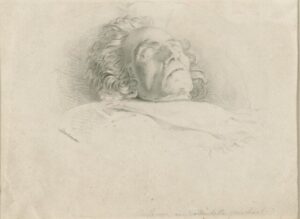There was also mercury and arsenic but none of the toxins likely caused composer’s death.
Last year, researchers sequenced the genome of famed composer Ludwig van Beethoven for the first time using authenticated locks of his hair. Recently, the same team analyzed two of these locks for toxic substances and found extremely high levels of lead, as well as arsenic and mercury, according to a letter published in the journal Clinical Chemistry.
“It definitely shows Beethoven was exposed to high concentrations of lead,” Paul Janetto, co-author and director of the Mayo Clinic’s Department of Laboratory Medicine and Pathology, told The New York Times. “These are the highest values in hair I’ve ever seen. We get samples from around the world, and these values are an order of magnitude higher.” However, the authors concluded that the lead exposure was not sufficient to kill the composer, though it likely caused him adverse health effects.

Beethoven was plagued throughout his life by various health problems. He began losing his hearing in his mid- to late 20s, experiencing tinnitus and a loss of high-tone frequencies. He claimed the onset began with a fit in 1798 induced by a quarrel with a singer. By his mid-40s, he was functionally deaf and unable to perform public concerts, although he continued to compose music.
Beethoven also suffered from chronic gastric ailments, including persistent abdominal pains and prolonged diarrhea. By 1821, he showed signs of liver disease, marked by severe attacks of jaundice. These issues affected his career and emotional state so profoundly that Beethoven requested, in a letter to his brothers, that his favorite physician examine his body after his death to determine the cause of his suffering.
By December 1826, Beethoven was very ill, suffering from jaundice, swollen limbs, fever, dropsy, and labored breathing. His doctor performed several operations to remove excess fluid from his abdomen. On March 24, 1827, he purportedly said to visitors, “Plaudite, amici, comoedia finita est” (“Applaud, friends, the comedy is over”). Two days later, he died. According to his friend Anselm Hüttenbrenner, who was present, lightning and a loud clap of thunder briefly woke Beethoven, who “opened his eyes, lifted his right hand and looked up for several seconds with his fist clenched… not another breath, not a heartbeat more.” An autopsy identified severe liver damage (evidence of cirrhosis) as the likely cause of death and significant dilation of the auditory nerve. However, the causes of his liver damage, hearing loss, and chronic stomach complaints have been debated for nearly two centuries.
Last year, scientists sequenced Beethoven’s genome using samples from five authenticated locks of hair. While the analysis did not pinpoint a definitive cause for his hearing loss or digestive problems, it revealed numerous risk factors for liver disease and a hepatitis B infection. Genetic evidence also suggested an extramarital affair in Beethoven’s paternal line.
Past scholars have attributed Beethoven’s hearing loss to otosclerosis or lead poisoning from the wines he preferred. While his contemporaries thought his alcohol consumption was moderate, standards were different in the early 19th century, and his “conversation books” show he was a regular drinker. He may have been drinking as much as a liter a day around 1825–1826. The wine in Beethoven’s time often contained lead sugar (lead acetate), with the corks pre-soaked in lead salt for a better seal. Alternatively, his health issues could have stemmed from complications when he contracted murine typhus in 1796.

Toxicological analysis of Beethoven’s hair had been done before, along with examinations of skull fragments. However, the lead poisoning argument largely rested on a lock of hair (the Hiller lock) that the 2023 analysis showed was not authentic and belonged to a woman. Therefore, the team performed toxicological testing on two authenticated locks using mass spectroscopy—the Bermann lock and the Halm-Thayer lock. The Hall-Thayer lock was particularly significant because Beethoven hand-delivered it to his friend, pianist Anton Hall, in April 1826.
The team found that the Bermann lock had lead levels 64 times higher than the upper limit of what is typical in a healthy person, while the Hall-Thayer lock had lead levels 95 times higher. This means Beethoven’s blood could have had between 69 and 71 micrograms of lead per deciliter. “Such lead levels are commonly associated with gastrointestinal and renal ailments and decreased hearing but are not considered high enough to be the sole cause of death,” the authors wrote.
The authors acknowledged certain limitations to their analysis. Hair samples can be contaminated by environmental lead or artificial hair treatments like dyes. However, there is no evidence that Beethoven used such treatments, and the study protocols removed any external contaminants before testing. While high lead levels in hair may not always predict blood levels, prior research shows a correlation between high lead hair levels and kidney and liver disease.
“While the concentrations determined are not supportive of the notion that lead exposure caused Beethoven’s death, it may have contributed to the documented ailments that plagued him most of his life,” the authors concluded. “We believe this is an important piece of a complex puzzle and will enable historians, physicians, and scientists to better understand the medical history of the great composer.”